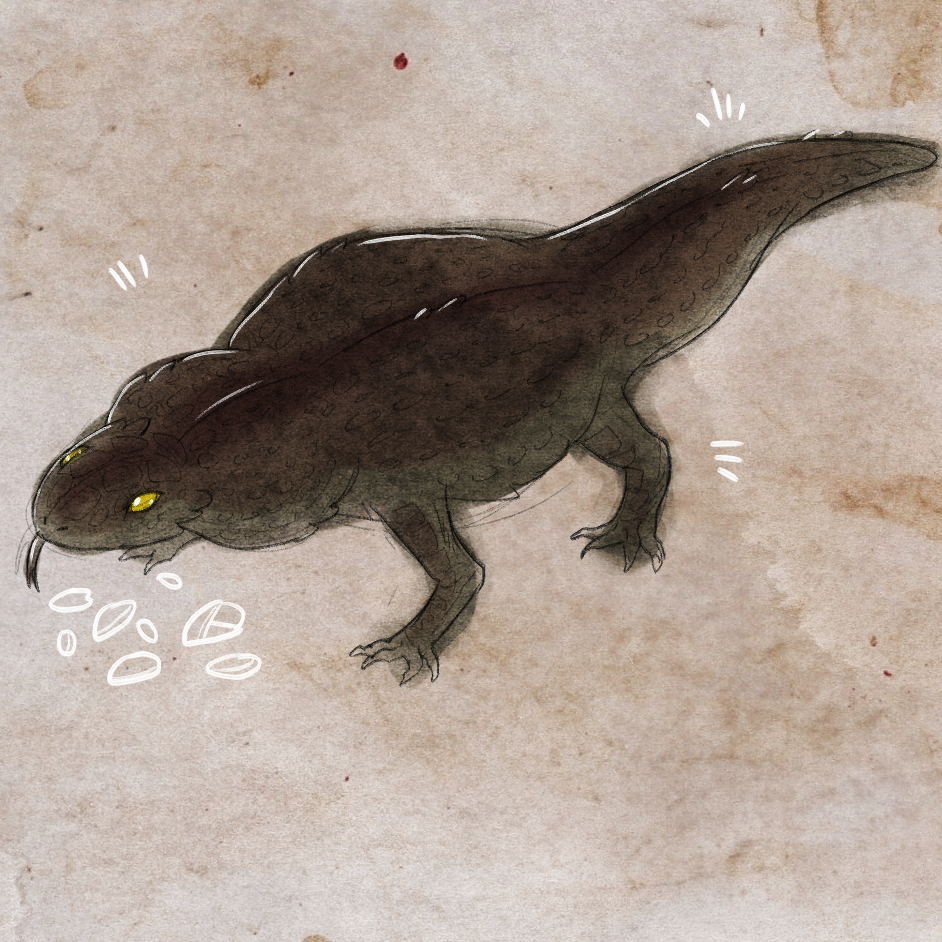Halu (NYM; /ˈhalau̯/, "Lizard")
"Oh, Grandmother feeds the halau at the same time every day. They know when to come, and will emerge from all the stoves and crevices to gather around her apartment steps. Then she feeds them for a hour until they disperse, but it's impossible to get in or out of her apartment block in the mean time."The halu is a common species of small lizard found in the Underworld. They are known for their chunky appearance and ease of ownership. They come in several varieties that can be found throughot the various layers of the Underworld.
Rats of the Underworld
Biology
Most halau live a average of 5 to 10 years, but have been known to live longer in captivity. They typically have flat, thick bodies covered in smooth to pebble-lie scales and sometimes small spines. They are all rather heat resistant, and can commonly be found basking on top of rocks next to open magma vents, or inside of Nymauti fireplaces and stoves. They reproduce nearly every year, and lay clutches of 4-6 eggs.Halau are omnivores, usually eating insects and Underworld fruits, but are also known for eating grain and other small animals when presented the opportunity. They respond to danger by often fleeing into spaces that might be too hot for other creatures to follow, or hissing and inflating their neck and sides to appear bigger when unable to escape. Their small, needle-like teeth can draw blood, but most halau species lack the jaw strength to do real damage.
Ecology
Halau are one of the most abundant animals in the Underworld, and can be found in plentiful numbers both in and out of occupied caverns. They usually gather around areas of active magma vents or other areas where Underworld plants might thrive, but can be found skittering in cooler, quieter tunnels as well. They are known for being particularly adept at seeking out new habitats and places of resource. Some species are more commonly seen in next to or in Nymauti cities, while others prefer the less-dwelled tunnels. They are accepted as part of the scenery.Hell's Easiest Pet
In Nymauti Society
Many species of halau are handled as pets by Nymauti demons, though some halau have been found to be too difficult to keep. The common brown halau, however, is one of the most beloved and frequently kept animals by Nymauti demons.As Pets
Most halau are known for being usually rather docile and easy to handle. They are sturdy and easy to feed, and fairly self-sufficient if allowed to roam. There are many morphs of that have come out of selective breeding, and there is a thriving scene in the underworld for halau breeders and keepers. The common brown halau is the most commonly kept and bred.In most surface countries or even many shallower Underground countries, halau are illegal to keep as pets, or require a permit to own.
Halau Species
Common Brown Halau
Common Brown Halau have brown-red scales, often with lighter bellies and a darker back. Hobby breeders have bred some common brown halau to have a deeper red color. They are one of the most plentiful species in the Underworld, and are frequently treated akin to pigeons.It isn't uncommon to find people feeding large swarms of common brown halau in Nymauti cities, nor is it uncommon to find them as household or court pets. Easy to care for with mild, amenable tempers, the common brown halau is the foremost pet in the Underworld. Most owners let them wander their neighborhood courtyard with other halau, domestic and wild, as fed halau are quick to return to where they know they are safe and fed. Almost all Nymauti Demon courts and squares have a roving band of pet halau, who may be owned by individuals or seen as a community pet as a whole. In some cases, they are known to be eaten, but many Nymauti cities frown on that.
Common brown halau are docile and well-mannered pets, known for being rather fond of handling. They are sturdy and are unbothered by roughness or events that might harm other lizards of their size, and are surprisingly tolerant to rough handling from children (not without puffing up sometimes of course). Their wide diet makes them easy to feed, and they are self-sufficient should a feeding be missed. They are known for being surprisingly cuddly, especially to races with warmer blood. While capable of surviving on the surface, they do not fair well in sunlight or without high heat, low humidity environments.



Comments